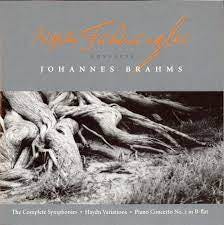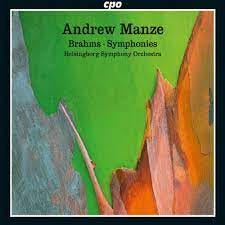“In my study I can lay my hand on the Bible in the pitch dark. All truly inspired ideas come from God. The powers from which all truly great composers like Mozart, Schubert, Bach and Beethoven drew their inspirations is the same power that enabled Jesus to do his miracles.”
- Johannes Brahms
Welcome back to Building a Classical Music Collection, where we are continuing our survey of the top 50 classical recordings of all-time. The #45 recording is a 1980 recording of Johannes Brahms’ Symphony no. 4 op. 98 by the Vienna Philharmonic Orchestra conducted by Carlos Kleiber on the Deutsche Grammophon label. You may recall the very first entry on our list featured Carlos Kleiber with the Vienna Philharmonic playing Beethoven’s Symphonies 5 & 7. Kleiber and the VPO return to our list with another nearly perfect recording, this time of Brahms’ final symphony.
Johannes Brahms
Johannes Brahms (b. 1833 – d. 1897) was a German composer of the Romantic era, and is generally regarded as one of the greatest composers of all-time. Even though Brahms was from the Romantic era, he was very much connected to the Classical forms as seen in the works of Haydn, Mozart, and especially Beethoven. In that sense, Brahms represented a “conservative” approach to musical tradition at a time when form and convention were changing due to Wagner and others. Brahms wrote symphonies and other orchestral works, chamber music, concertos, keyboard works, vocal, and choral music.
Brahms was from a musical family in Hamburg, and showed a great deal of promise even at a young age. He began as a pianist, and would often perform around Hamburg in eating and drinking establishments. By adulthood, Brahms had become friends with well-known musicians of the time. He befriended the violinist Joseph Joachim, a relationship that would be personally and artistically important throughout his life. But perhaps most important was his friendship with the famous composer Robert Schumann. Schumann, twenty-two years older than Brahms, became his most fervent advocate. Brahms likewise had tremendous esteem for Schumann. Brahms practically became a member of Schumann’s family, and after Schumann’s death at the too young age of 46, Brahms continued to be close friends with his widow, the pianist and composer Clara Schumann. Brahms never married, although he apparently had several romantic relationships throughout his life. There is speculation about whether Brahms and Clara were more than friends, and there is evidence that Brahms was probably in love with her.
Many of Brahms’ compositions have become universally known, and many are perennial favorites that are frequently programmed by orchestras around the world. As part of the “Big 3” of Bach, Beethoven, and Brahms, he occupies a central place in the history of classical music. Previously included on this list of the top 50 classical recordings was a recording of Brahms’ Ein Deutsches Requiem (A German Requiem). If you are interested, you can find that review here:
Brahms Symphony no. 4
Brahms was already 43 years of age when he completed his First Symphony in 1876, although he had begun work on it back in 1860. Brahms was a mature composer by this time, but the symphonic form seemed to present some challenges for him. Brahms was often cautious and self-deprecating in talking about his symphonies, but the premiere of the First was warmly received. Even so, Brahms continued making changes to it for quite a while after it was public.
Thereafter followed several great successes for Brahms, including his Second Symphony, his Violin Concerto, the Academic Festival Overture, and the Tragic Overture. Brahms was given an honorary degree from the University of Breslau, where he was described as "the leader in the art of serious music in Germany today". This did not sit well with fellow composer and archnemesis Richard Wagner, who responded by commenting, "I know of some famous composers who in their concert masquerades don the disguise of a street-singer one day, the hallelujah periwig of Handel the next, the dress of a Jewish Czardas-fiddler another time, and then again the guise of a highly respectable symphony dressed up as Number Ten" (this last point referring to Brahms's First Symphony as it was sometimes disparagingly called the tenth symphony of Beethoven). Brahms and Wagner originally had a cordial relationship, but over the years it soured as Wagner insulted Brahms’ traditionalist approach. Wagner was forward-looking, while Brahms was more backward-looking, or so they were portrayed. For his part, Brahms continued to admire Wagner, even working to have some of Wagner’s works premiered in Vienna.
Brahms struck up a friendship with the well-known conductor Hans von Bulow, who in 1882 had offered Brahms the opportunity to premiere his Piano Concerto no. 2 with his Meiningen Court Orchestra. Von Bulow would champion Brahms’s works from that point forward, telling his wife, "You know what I think of Brahms: after Bach and Beethoven the greatest, the most sublime of all composers." 1883 saw the premiere of Brahms’ Third Symphony and finally in 1885 his Fourth Symphony. These last two symphonies earned the admiration of fellow composer Richard Strauss, who commented about the Fourth that it was "a giant work, great in concept and invention".
Brahms’ Fourth Symphony follows the traditional four movement symphony structure with the following movements:
Allegro non troppo
Andante moderato
Allegro giocoso - Poco meno presto - Tempo I
Allegro energico e passionato - Piu Allegro
The Fourth has a serious, even tragic, tone. It is a passionate, essentially Romantic work, though as always Brahms retains the Classical structure passed on from Mozart and Beethoven. Famed English musicologist Sir Donald Tovey stated, “No one experienced in great music could fail to see that the Fourth Symphony’s long quiet opening sentence is the beginning of a great and tragic work”. Tovey later praised the work as “one of the greatest orchestral works since Beethoven,” and singles out the end of the first movement, which “bears comparison with the greatest climaxes in classical music, not excluding Beethoven.”
Richard Osborne comments further:
“Few symphonies begin with so obviously brave and determined a sense of tragic journeying; nor does any complete its journey with more unremitting honesty, fiercely in the minor key, stormily confronting its own destiny…Brahms’s E minor Symphony being an abstract work of music, has no plot, no narrative, yet it is absolutely congruent with the ancient tragic style…After Brahms completed it, the following year, he warned (with good reason, as it would turn out) that some might find it unduly stern: “It tastes of the climate hereabouts. The cherries are hardly sweet here. You wouldn’t eat them!”.
It appears Brahms actually took the theme in the final movement from a song in a Bach cantata. So while there is much original about the symphony, Brahms as usual pays homage to his predecessors.
Michael Rodman in the All Music Guide takes us through each movement:
“Each of the movements bears the distinct stamp of the composer’s personality. The first begins with a theme in E minor based upon the interval of a third, which also provides a structural and motivic foundation for the remainder of the work. There is a notable sense of unrest from beginning to end, and the tragic, even fatalistic atmosphere is further and stunningly underlined by the final, minor-key cadence.
The second movement, which opens with a brief, melancholy sort of fanfare, gives way to the quietly accompanied winds in perhaps one of the loveliest of any of the composer’s themes.
The third movement Allegro, a lusty, stomping, duple dance, proved so popular in Brahms’ lifetime that audiences constantly demanded that it be repeated.
The last movement is perhaps most notable of all, cast as it is in the “archaic” Baroque form of a chaconne - variations over a ground bass. The chaconne’s subject is in fact a slight modification of that used by Bach in his Cantata no. 150; though deceptively simple, Brahms uses this skeleton as the basis for an increasingly elaborate and thematic harmonic framework…Brahms gradually weaves some 34 variations that steadily build in intensity, as though in defiance to the oppressive, insistent rotation of the ground. The final variations lead directly into an ending which reconfirms the weight of tragedy and pathos borne by the first movement.”
The work was given its premiere in Meiningen on October 25, 1885, with Brahms himself conducting. Infamous Vienna music critic Eduard Hanslick wrote, "for the musician, there is not another modern piece so productive as a subject for study. It is like a dark well; the longer we look into it, the more brightly the stars shine back."
The Recording
Carlos Kleiber again! His recording of Brahms’ Symphony no. 4 made with the Vienna Philharmonic in 1980, in the early days of digital recordings, was an instant classic. The genius Kleiber left us precious few recordings, and so just about every recording he made became an event. Along with his recordings of Beethoven’s Fifth and Seventh symphonies, his Brahms Fourth enters the top 50 recordings of all-time.
I should admit now that Brahms’ Fourth is not my favorite Brahms symphony. That would be Brahms’ First Symphony, its final movement being one of the greatest creations in the history of music. But the Fourth is more consistently expressive from start to finish and more intensely felt.
I have listened to many, many recordings of Brahms’ Fourth, and many of them sound similar to each other, which I attribute to Brahms’ clear indications and markings. Therefore, standing out in a crowded field takes something extra. What does Kleiber bring to the score? Adrenaline. Clarity. Precision. Detail. Drive. It doesn’t really need to be said, but the Vienna Philharmonic are absolutely brilliant on this recording, carrying out Kleiber’s wishes down to the smallest detail. The sound is excellent, avoiding some of the overly bright digital glare present in many of the first digital recordings.
My first impression of Kleiber’s reading of the first movement Allegro non troppo was that it is rather ordinary. I liked it, and of course it is well-played, but I didn’t hear anything extra special. However, that all changed in the next three movements as Kleiber increases tension and does not let it up. It is a strong, individual, and driven vision of the work high on intensity and energy. One quality of this recording is the incredible playing of the orchestra where they play with amazing coordination and togetherness. To me, this is one of the rare recordings where the entire orchestra sounds like one large instrument playing in unison.
The second movement Andante wears its pathos and beauty on its sleeve, but even here Kleiber doesn’t linger too much. You may notice in the third movement Allegro giocoso, taken at a good clip, how well Kleiber controls the tempo and dynamics, where it almost feels like he has the orchestra on a string he can push and pull. It is truly extraordinary. The clarity of the textures has never been heard as well, and if Kleiber does not bring out every last ounce of lyricism, he more than compensates with his rhythmic and dynamic acuity. The finale also moves along at a faster than usual pace, but it feels almost propelled forward by an inexorable momentum. There are a few moments of relative peace within the movement, but Kleiber does not give these moments comfort, but rather moves on steadily toward the storm that is coming. And come it does, with the horn call heralding tremendous terror and calamity in the middle of the movement. Angry waves rise and fall, tension rises, but Kleiber keeps tight control over things with the orchestra bringing some astonishing articulation as well as packing a powerful punch. The final attack is resolute and confident, while uniquely emotional. I am always in awe at the precision of the VPO ensemble in the final movement on this recording. Brahms’ final symphony comes to a devastating, but satisfying, conclusion in the hands of Kleiber and the VPO. I am left with the overwhelming feeling that this is exactly how this great work should sound, and it is as near perfect as you are likely to find in a recording.
Other recommended recordings
As was often the case with the German masters, Wilhelm Furtwangler’s way with Brahms’ Fourth is epic in scope and shattering in impact. His live war time recording with the Berlin Philharmonic from December 1943 on the Music & Arts label is the most famous. I also greatly enjoy his 1949 live recording with the BPO on the Archipel label. His EMI (now Warner) recording from a year earlier is also very good. In short, any of Furtwangler’s recordings of the Fourth reveal why he is mandatory listening in this symphony. Allowances need to be made for dated sound quality, so bear this in mind. But the performances are like nothing else, the final movement being built into a complete frenzy.
Fritz Reiner, the legendary conductor of the Chicago Symphony Orchestra where they made many outstanding recordings, recorded Brahms Fourth with the Royal Philharmonic Orchestra in London in 1962 for Readers Digest, for a time available on RCA in the 1960s, now available for purchase on the Chesky label (although I cannot find it for streaming anywhere). This is definitely a recording worth purchasing if you love the Fourth. Reiner himself reportedly thought this was his best recording, and it ended up being one of his last before his death. The RPO plays for their lives, and it is a performance of unusual feeling and depth. It contains explosive fire to be sure, and yet Reiner emphasizes the lyricism too. The sound is very good for the time period.
Leonard Bernstein’s later recording of Brahms’ Fourth with the Vienna Philharmonic on Deutsche Grammophon is the highlight of the complete set, and one of the best versions available. Taken from a live recording in 1981, not long after Kleiber with the same orchestra, we are able to hear a lot of similarities with Kleiber, but also some differences. Bernstein was not a technician like Kleiber, and so it is a somewhat less disciplined performance. But no less exciting, with brilliant horns and that wonderful Vienna string sound, along with resonant yet detailed sound from DG. Here Bernstein doesn’t let the speeds drag as he does on some other recordings from the same time period, that is until the final movement where he can hardly be faulted for turning the final movement into something more like Mahler (as Bernstein tended to do in that last decade of his career).
German conductor Eugen Jochum was among the best interpreters of Brahms, and he recorded the complete set of symphonies twice, first with the Berlin Philharmonic on DG and later with the London Philharmonic Orchestra for EMI (now Warner). Both sets are recommendable, but the second set recorded in 1976 for EMI has better sound. The Fourth with the LPO is played with urgency and fullness of tone, the strings, brass, and woodwinds all caught superbly. The final movement is particularly moving, with the lovely wistful section in the middle followed by the supremely terrifying eruption leading into the final section.
Several attempts have been made at historically informed performances of Brahms’ symphonies, and I must admit I am not a fan in general of the approach using period instruments, less vibrato, and faster speeds, at least not for Brahms. Complete Brahms sets by Sir Charles Mackerras, John Eliot Gardiner, Roger Norrington, and others are available but for me don’t plumb the depths of Brahms’ music. One recent exception is the set by Baroque specialist and violinist Andrew Manze with the Helsingborg Symphony Orchestra on the CPO label. Using modern instruments, but with a smaller orchestra, Manze is able to produce playing of exceptionally refined, crisp, and exciting quality. The Fourth in particular is very exciting, and although the lack of a bigger sound is noticeable, Manze is effective at bringing out the emotion and lyricism better than other HIP conductors. Speeds are moderate, never breathless, and the recorded sound is immaculate. A really great option.
Last but not least, Otto Klemperer recorded the entire Brahms symphony cycle in the late 1950s with the Philharmonia Orchestra for EMI and producer Walter Legge. Klemperer’s Fourth remains one of the finest versions with remarkably detailed early stereo sound. Klemperer takes things slightly slower than we are accustomed to now, and certainly slower than Kleiber. However, what Klemperer brings is an uncanny sense of rhythm, dynamics, and drama. The way he gets the orchestra to crescendo on each of the big notes toward the end of the final movement is thrilling. Klemperer has stood the test of time.
It is true that there are many other good to great recordings of the Fourth that you may want to sample including those by Karajan, Bohm, Wand, Toscanini, Steinberg Harnoncourt, Rattle, Barenboim, Chailly, Thielemann, Walter, and others. They all have their merits, and you may enjoy finding out where those merits lie! Happy listening!
___________________________
Notes:
Brennan, Gerald. Rodman, Michael. Schrott, Allen. Woodstra, Chris. All Music Guide to Classical Music, The Definitive Guide. All Media Guide. Pg. 189. Backbeat Books, San Francisco. 2005.
Musgrave, Michael (2000). A Brahms Reader. New Haven and London: Yale University Press. ISBN 978-0-300-06804-7.
Osborne, Richard. Carlos Kleiber Conducts Brahms. Johannes Brahms Symphony no. 4. Deutsche Grammophon linernotes Pp. 2-3. 1998.
Pleasants, Henry (1963). Music Criticisms 1846-99 Eduard Hanslick. Penguin Books. pp. 243–245.
Swafford, Jan (1999). Johannes Brahms: A Biography. London: Macmillan. ISBN 978-0-333-72589-4.
Taruskin, Richard (2010). Music in the Nineteenth Century. Oxford: Oxford University Press. ISBN 978-0-19-538483-3.
https://www.azquotes.com/quote/1342011
https://topear.wordpress.com/2012/08/07/comprehensive-review-brahms-4th-symphony








